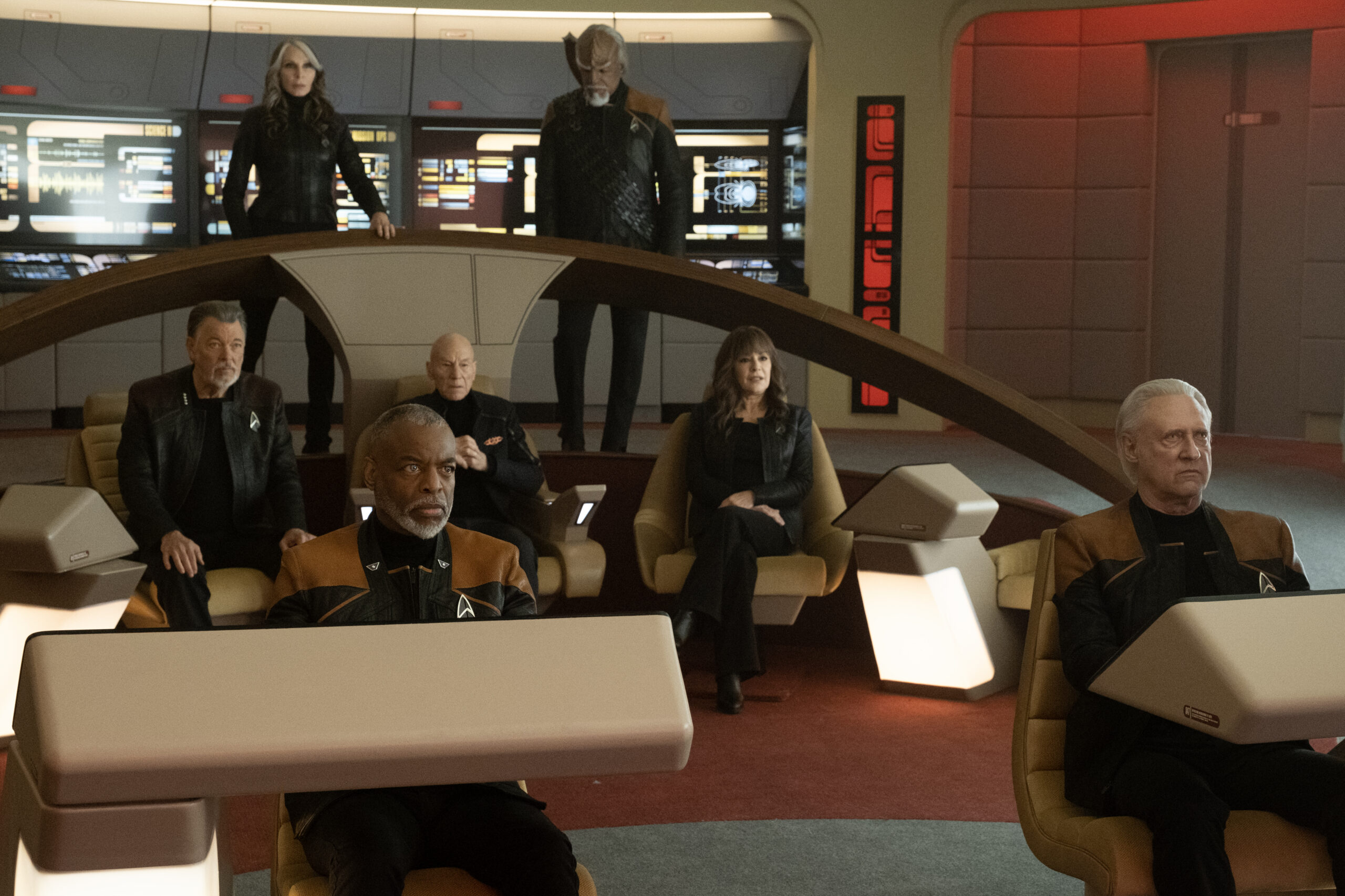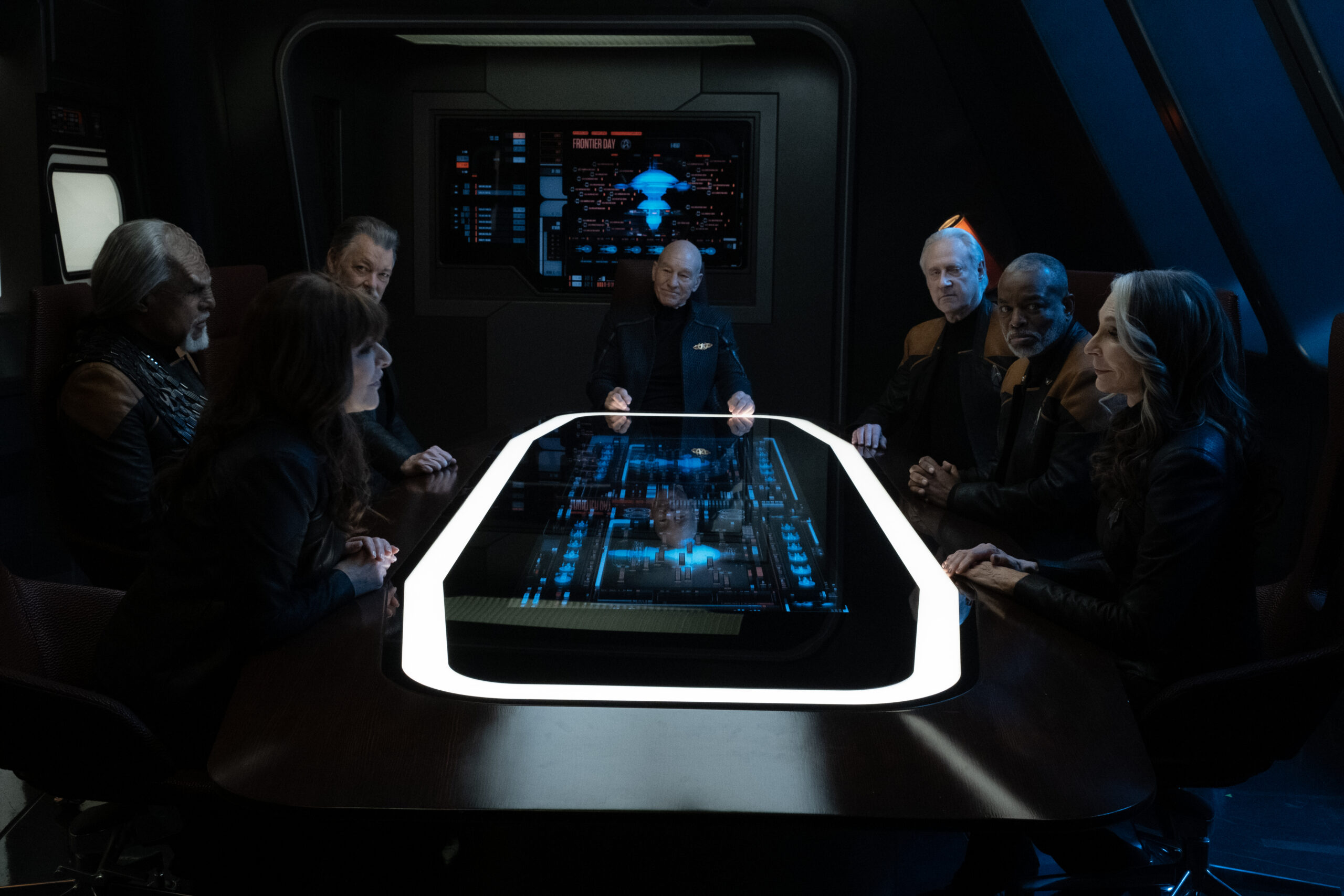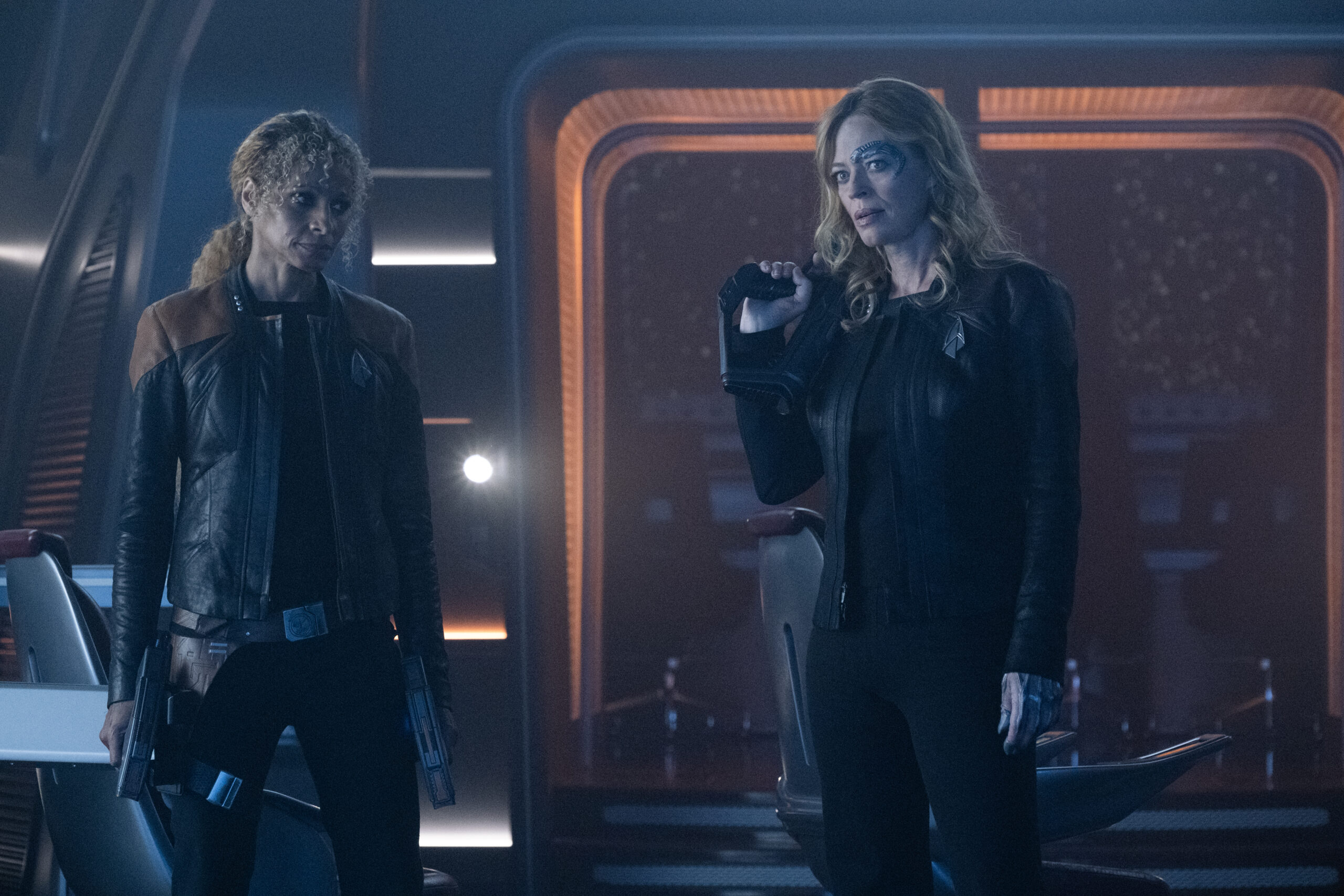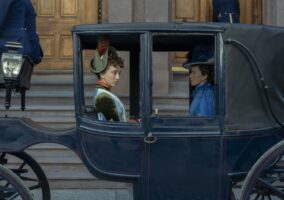
If we could sum up the theme or the point of season 3 of Star Trek: Picard in one sentence, it would be something like, “In case you may have forgotten, here’s a reminder that these people are really good at their jobs.” We’re referring not only to the crew of the Enterprise D, but to the actors who brought them to life and sustained their legacy through five decades.
But if we want to take a broader view, the major question hanging over season 3 of Star Trek: Picard is one that encompasses nostalgia, fandom, and pop culture franchises. It’s a question of where you draw the line that separates telling a good story and tickling the nostalgia centers of the brain by providing pure fanservice. Then there’s the follow-up question: If a story really is fanservice, is that necessarily a bad thing? Is it a lesser attempt? Is its value reduced? Because we’ll tell you something: Star Trek: Picard‘s first two seasons attempted to do something new with its main character and the results were largely pretty terrible. Season one had a few good moments, but it’s still a little crazy to us that Jean-Luc died and they made an android version of him that everyone pretends is the same being. That development had nothing on the conclusion to season two, which had both Seven and Jean-Luc, who have talked about how they remain traumatized by their assimilations, watch with loving acceptance as their friend is turned into the new Borg Queen. Suffice it to say, while we initially enjoyed the possibility of seeing Jean-Luc Picard in a new phase of his life with little of his old baggage attached to him, the attempts failed to sell us on the idea. The fact is that Jean-Luc Picard was created as the lead of a specific ensemble of characters who were developed specifically to react to him in different ways and bring out different sides of him. The Next Generation series finale “All Good Things” was based entirely on this idea and closed the series making the point that the Enterprise D crew was Jean-Luc’s family. When you remove that ensemble as a support system, it’s nearly impossible to hold on to what made that lead character so great. We don’t think a Star Trek: Sisko or Star Trek: Janeway series would have fared any better had they completely removed their supporting casts.
It was very much to the show’s credit that it took its time bringing the iconic cast back together, letting the story unfold in a manner that made about as much sense as any Star Trek story ever has (which is to say it had its share of plot holes, hand-waving, and pure technobabble) and having each former crew member return in ways that didn’t feel too forced (most of them, anyway). Had it been ten episodes – or even half that number – with the entire Next Gen cast working together, the specialness of these last two episodes would have been greatly reduced. The thrill of watching them take their places on the iconic Enterprise D bridge would not have been the same if we didn’t have to wait for it. Every member of the cast slipped easily back into their old characters and each of them were given several moments to remind us why we loved them in the first place. We have to pay a little attention to season MVP Gates McFadden, who did her very best work as Beverly Crusher. You could feel her relief and enjoyment as an actress to finally be given something meaty and interesting to do after a decade of standing around and pointing things at people while looking concerned. To be fair, everyone in the cast was doing Personal Best work. Jonathan Frakes came off like he was having the time of his life and Michael Dorn could do Worf in his sleep at this point (and did). And what Next Gen fan didn’t get a little thrill every time Geordi said “Aye, sir”? Who didn’t love hearing the late Majel Barrett’s voice as the Enterprise D’s computer? Buttons were pushed – and we don’t mean the LCARS ones.

You have to remember – in fact, watching them together, it’s difficult to forget – that these people not only worked together on hundreds of hours of film and television, they’ve also been appearing together at fan conventions and in tributes on and off for the last twenty-plus years. You just can’t find a cast with as long a professional and personal history as that. Not even the original Star Trek cast worked together as much as this cast has (Next Gen outpaces them by an extra hundred episodes of television). And they’ve all been talking about, re-examining, and explaining their own characters to thrilled audiences of fans for decades – and listening to those fans in return telling them what their characters meant to them. All of that winds up in the mix of a season like this. There have been a lot of reboots and returns to classic shows and movies in the last decade or so, but very few of them carry as much personal history and emotional weight as this cast.
But it was not without its issues as a story. Vadic (a deliciously campy Amanda Plummer), the Changelings, and the fallout from the Dominion War were all dropped from the story after a massive buildup. We could take the charitable view and see it as a savvy misdirection to keep us from figuring out that the Borg were the true enemy, but wasn’t that somewhat obvious early on? We never once considered that Jack’s condition was anything other than some sort of Borg infection, partially because we knew Jean-Luc’s DNA had been rewritten by his assimilation and there have been several references – some in this series, but the main ones coming from Star Trek: First Contact – that Jean-Luc was never fully UN-assimilated; that some aspect of his Borg identity still lingered under the surface. Seven alluded to this in a conversation with him in season one, when they first met. But really, we figured it was the Borg early on simply because they’ve been a feature of this series from the beginning (season one took place on a Borg cube and killed off ex-Borg characters Icheb and Hugh, while season 2…look, just don’t get us started on that again, okay). To us, it made the most sense to use them if you’re bringing the entire Enterprise D crew back in service. Yes, they’re a wildly overused aspect of Star Trek canon, but if any one cast is the most worthy to face them again, it would have to be the Next Generation cast. To pull from a completely different reference, the Borg are Picard’s Moriarty. It would be great if we never saw them again, letting Janeway’s and Picard’s actions stands as the death knell for the entire race. Trek being Trek, that probably won’t be the case.
And while were at it, what exactly did the Changelings ever get out of their partnership with the Borg? Why did the Borg Queen act like Vadic’s superior? Once the Changelings figured out how to infiltrate Starfleet, what did they need the Borg for? Also, why is Data alive and old? Okay, fine. They did explain that last one but boy, did they ever stretch the technobabble to its limit setting it up. And if we’re listing complaints here, we may as well go ahead and say that it tends to make Starfleet look small, aged and insular when you limit its portrayal to characters you’ve seen before (or their children). Not that we minded seeing Tuvok again. And man, that Ro Laren episode was just a gift to the fans, not only tying up a very old loose thread, but letting one of the original series most intense and interesting relationships come to its natural end as two hurt people tore chunks off each other, poking at old wounds. Michelle Forbes and Patrick Stewart were fantastic in their scenes together. We had to laugh at the return of Elizabeth Shelby, however. She lived exactly long enough for Picard and Riker to get in one more “Get a load of this piece of work.” They never could stand her. Star Trek has always been good about depicting women in command positions, but there is an incredibly long line of bitchy or ineffective female Admirals. It’s practically a tradition at this point.
The season lifted from or paid homage to a whole bunch of Trek history, referencing not just Next Generation, Voyager and Deep Space Nine, but also First Contact, Nemesis, The Wrath of Khan and even The Voyage Home. It also felt like it was taking a little from Star Wars, with its epic space battles, rogues, and dynastic view of heroism, but it ended on a totally Tolkienesque Return of the King note as every character got the most loving of extended sendoffs. We got to see each of these characters say goodbye to each other in the heat of a hopeless battle as if they were going to die (Jean-Luc’s final “It has been an honor to serve with you all” on the bridge was especially poignant, thanks to Stewart’s delivery) AND we got the happy ending with all of them laughing and loving together happily. Talk about the best of both worlds. Yes, it pushed every single nerd nostalgia button it could locate, but who can deny the pleasure of watching all of our space moms and dads getting sloppy drunk and playing poker?

But it wasn’t all nostalgia for the sake of nostalgia. Showrunner Terry Matalas (who also wrote and directed the finale) used all of that backstory to set up an ending that was forward-facing. One of our favorite things about the Picard series as a whole is how it established a meaningful relationship between Jean-Luc and Seven of Nine. We’ve long considered Jeri Ryan to be among the top tier of Star Trek actors and Seven was one of the best characters created in modern Trek. After having been mentored by the legendary Captain Janeway, we think it makes perfect character sense for her to become equally in awe of the legendary Captain Picard, with whom she shares a unique bond as former Borg. While there were parts of the season where she was relegated to background character status, we like that they gave her an arc where she went from questioning why she ever let herself be influenced by these Starfleet legends to pretty much becoming a legend herself, fulfilling her stated dream to inspire and lead. We should also note what a great job Todd Stashwick did as Captain Liam Shaw. It’s damn near impossible to come into Star Trek as a new captain character and win over the fans (just ask Sonequa Martin-Green) but Shaw was a fantastic addition right from the jump. Star Trek has had plenty of Starfleet assholes in its history, but Stashwick brought a real sense of fun to his “dipshit from Chicago” and played off the iconic cast beautifully. If there’s a sequel series coming, they better hand-wave a way into bringing him back. It was also nice to see Raffi get closure on her three-season-long arc, getting her family and her reputation back. We’ve heard some grumblings about this character, but we always liked Michelle Hurd’s scenery-chewing. It fits right in with some of the most beloved hams in Star Trek, from Shatner to Frakes, deLancie to Picardo. And she’s the only original character who stuck around through the whole series. Some of the rushed shuffling that went on in the last few minutes didn’t entirely appeal to us (we’re still getting used to the idea of the newly christened Enterprise G being so small, relatively speaking), but the idea of two hot middle-aged lesbians with great hair serving as the Enterprise’s Captain and First Officer is a Trek twist we can really get behind. We don’t know if the rumored Star Trek: Legacy series is ever truly going to happen, but they’ve done a great job of setting up a series that allows the 25th Century version of Star Trek to continue, something we’d much rather see than Discovery’s leap a millennium into the future or even Strange New Worlds‘ reimagining of the “past,” fun as it is. Having said that, we can’t say we love the idea of Skywalkering the Picard family line. Jean-Luc’s and Beverly’s son doesn’t need to be situated at the forefront of every major conflict just because of his parentage. In our opinion, Jack Crusher is a character best taken in small doses. He’s obnoxious by design, which tends to make him more of a foil than a lead. It’s a bit silly to see him taking a senior position on the Enterprise bridge with so little Starfleet experience under his belt, but he wouldn’t be the first Crusher son to do so. We won’t deny there was a certain delight in seeing a hale and hearty Q pop up again, but the after-credit scene left us pretty flat, especially since it all but stated that they’d like to rerun all of Jean-Luc’s greatest narrative hits with his son. If Star Trek: Legacy is to be a thing, then we’d like very much for it to be its own thing and not a place to do updated versions of classic Next Generation storylines. The reason Next Gen eventually worked as a series is because it specifically tried not to be identical to its predecessor series. It tried to advance and improve on the original series. If there’s any takeaway from the critical and viewership success of this series and the returning Strange New Worlds is that modern Star Trek works best when it’s aware of its own past, secure in the knowledge of what the fans love, and willing to be modern and forward-looking in the middle of nostalgic story beats and references. It’s a very tiny needle to thread and it’s something both Star Trek and Star Wars have been struggling with in recent years. The IP is strong and the fanbase is willing, but somehow you have to deliver a new story with new characters while paying homage to the past constantly. Star Trek: Picard season 3 just wrote the blueprint on how to do nostalgic fanservice while telling a fantastic story at the same time.
Sarah Michelle Gellar Attends Handprint Ceremony at the Canneseries International Festival in Zimmermann Next Post:
Honor Spring 2024 Bridal Collection
Please review our Community Guidelines before posting a comment. Thank you!



